 Astronomers on Earth observe that the frequency of the light emitted by stars on one side of the Milky Way Galaxy is higher than the frequency emitted on the other side. What might cause this frequency difference? Astronomers on Earth observe that the frequency of the light emitted by stars on one side of the Milky Way Galaxy is higher than the frequency emitted on the other side. What might cause this frequency difference?
 Erin is conducting an investigation by setting up two stereo speakers facing each other and 2 m apart. She sets the stereo to play a note with a wavelength of 1 m. The speakers play in phase with each other. Erin is conducting an investigation by setting up two stereo speakers facing each other and 2 m apart. She sets the stereo to play a note with a wavelength of 1 m. The speakers play in phase with each other.
- If she sits halfway between the two speakers, what does she hear?
- If she moves somewhat closer to one speaker than the other, what will she hear?
- What will Erin hear if she changes one speaker to play a note with a wavelength of 1.1 m and then sits halfway between the speakers?
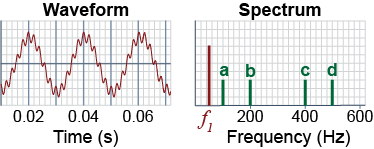
 The waveform on the left contains two component frequencies. One is labeled f1 on the spectrum. Which peak on the spectrum is the other frequency, a, b, c, or d? The waveform on the left contains two component frequencies. One is labeled f1 on the spectrum. Which peak on the spectrum is the other frequency, a, b, c, or d?
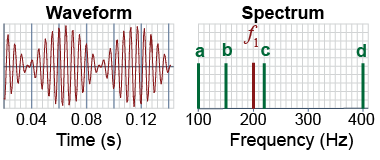
 The waveform on the left contains two component frequencies. One is labeled f1 on the spectrum. Which peak on the spectrum is the other frequency, a, b, c, or d? The waveform on the left contains two component frequencies. One is labeled f1 on the spectrum. Which peak on the spectrum is the other frequency, a, b, c, or d?
 A hiker in the middle of a canyon yells “Echo!” and then 4 s later hears his echo off of the walls of the canyon. How far away are the walls of the canyon? A hiker in the middle of a canyon yells “Echo!” and then 4 s later hears his echo off of the walls of the canyon. How far away are the walls of the canyon?
 A guitar string plays a fundamental note with a frequency of 335 Hz. A guitar string plays a fundamental note with a frequency of 335 Hz.
- What are the frequencies of the first, second, and third overtones?
- What are the frequencies of the first, second, and third harmonics?
| | 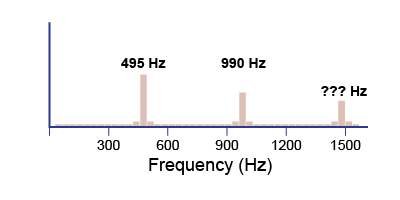
 The spectrum above shows frequencies of a vibrating string one second after it was plucked. The spectrum above shows frequencies of a vibrating string one second after it was plucked.
- What is the quantity plotted on the vertical axis?
- Why are only some frequencies present and not others?
- What is the fundamental frequency for the string?
- What is the value of the missing resonant frequency?
- How did you infer the missing frequency?
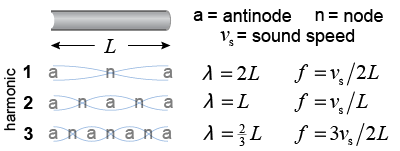
 When blowing on a pipe with both ends open, a musician creates standing waves that have antinodes at both ends (because air molecules at both ends are free to oscillate back and forth). The diagram shows the nodes, antinodes, wavelength, and frequency of the first three harmonics. When blowing on a pipe with both ends open, a musician creates standing waves that have antinodes at both ends (because air molecules at both ends are free to oscillate back and forth). The diagram shows the nodes, antinodes, wavelength, and frequency of the first three harmonics.
- Write a formula that calculates wavelength (λ) when one knows the distance d between any node and the nearest antinode.
- Write a formula that expresses wavelength in terms of pipe length L and harmonic number nh.
- Write a formula that expresses frequency in terms of pipe length, harmonic number, and sound speed vs.
- Given a sound speed of vs = 343 m/s and a 35-cm-long pipe with two open ends, what will be the frequency of the fourth harmonic?
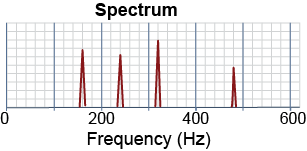
 The spectrum shown here represents a musical sound, but parts of the spectrum are missing. The spectrum shown here represents a musical sound, but parts of the spectrum are missing.
- What is the highest possible fundamental frequency?
- There are three missing frequencies in the range from 0 to 600 Hz. What are they?
|

